#or a mustang tremolo
Text
i wonder if i can stick a jazzmaster tremolo on my strat
0 notes
Text
Marshall Guv`nor: a Pedal that sounds like a Tube Stack

To be more accurate, it sounds like a valve stack; after all, it is a British pedal imitating British Marshall amplifiers.

Don't tell anyone because it's a secret: when creating his JTM45, Jim Marshall actually copied the circuitry of a 1959 Fender Tweed Bassman 5F6-A.
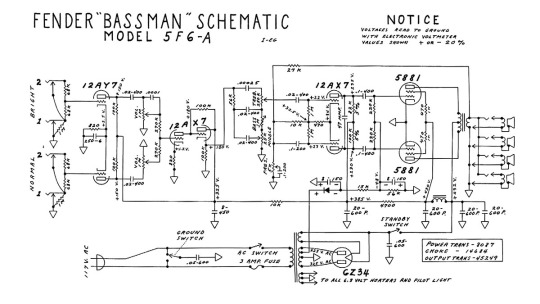
And Mr. Marshall also equipped his first 50-watt combo amplifier, a 1961 JMP Tremolo “Bluesbreaker,” with four 10-inch speakers. The iconic 2x12" version was made a year later.

Tolex instead of tweed, a horizontal arrangement of tubes, and ring-shaped loudspeaker magnets—the differences end there.
But why does the British Marshall sound so different from the American Fender? Is the difference really just the Celestion speakers instead of the Jenhsen ones with their U-shaped magnetic core?

The stronger magnetic field of British loudspeakers compresses the sound's dynamic range to a significant extent. One can compare the waveforms recorded with the Shure SM57 microphone from the 12" Celestion G12M Greenback and Fender Mustang II (V1) loudspeakers, as well as from the 8" Orange Voice of the World PPC108.
But the spiciest part of the Marshall sound is literally based on the usage of British valves instead of American tubes.

In the post about a simple DIY tube guitar amplifier, we already noted that the sound of a particular tube depends on the geometry of the grids and anode.
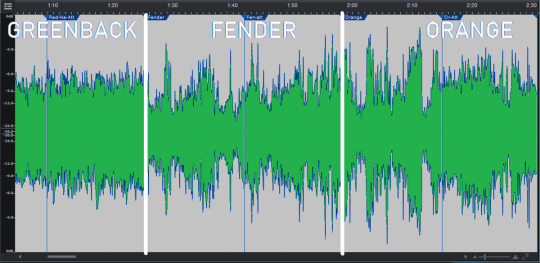
And if we compare 12AX7 preamp tubes with ECC83, we will see and hear that they are all very different. This is determined not by an American or European stamp but by the design of this particular unit from a particular manufacturer.
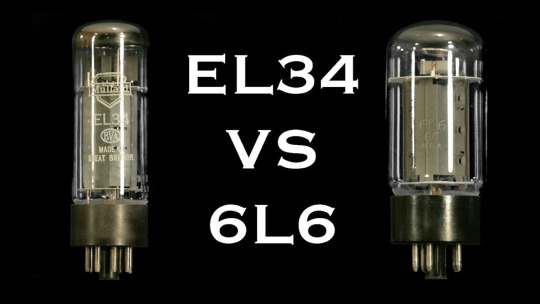
It's a completely different story with the EL34 and 6L6 power amplification output tubes. Their sound difference is on another level. Short and thick American 6L6 can be described as high fidelity with a large headroom; long and thin English EL34 is, on the contrary, a growling and roaring powerhouse due to the fact that it tends to limit and distort the signal.
Does this mean that if you swap the speakers and tubes in the Tweed Bassman and Bluesbreaker combos, the Fender 5F6-A would become a Marshall JTM45? Not really, no.
In the universe of guitar amplification, nuances matter: the cabinet's open or closed back wall, the fine selection of component values, and the frequencies to which the tone controls are set.
And, of course, the sound is influenced by the anode supply rectifiers and the supply and output transformers. And according to some experts, even the material of the chassis matters: the windings of transformers have considerable leakage inductance, and their alternating magnetic field interacts with the metal of the chassis.
Then there's another question: is it possible to emulate all these effects without real tubes, bulky loudspeakers, and heavy multi-pound transformers? A guitar amplifier is a complex yet still measurable device; it's subject to the laws of physics and can be mathematically evaluated.
There is no doubt about the possibility of recreating a certain sound by other means. The question is how complex the circuit with transistors and ICs will be sufficient to obtain a convincing effect.
The idea to replicate the iconic sound of the Marshall JTM 45 and JCM800 in a pedal body and create the world's first amp-in-a-box, oddly enough, first came to none other than the employees of the Marshall company itself, led by the head of the Development Department, Steve Grindrod.
Guitarists worldwide owe a debt of gratitude to this man for developing the legendary Marshall JCM800 and Vox AC30.
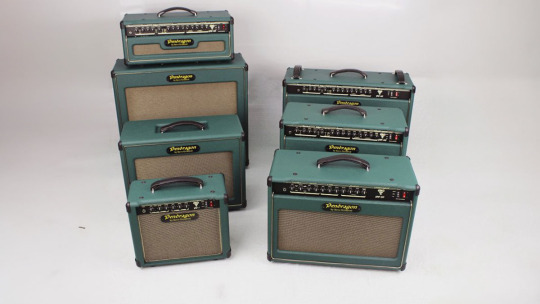
Today, the godfather of British Sound owns his company, Steve Grindrod (Albion) Amplification. He produces Pendragon guitar amps and Gypsy Boy acoustic amps and works with various charities. And in 1988, his efforts led to the creation of the Guv’nor pedal.
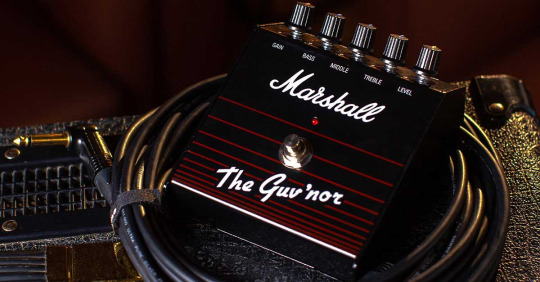
In 1992, the pedal was re-released under the name Drive Master. It differed from the original only without an effects loop jack.
The circuit looks like a regular distortion pedal with two operational amplifiers. The first is included as a non-inverting amplifier; the signal is supplied to the non-inverting input. And the second operational amplifier is used in the inverting connection.

The drive regulator potentiometer is configured to control the negative feedback of both op-amps. This is a brilliant design by Steve Grindrod.

By comparison, Orange tube and transistor amplifiers typically use dual, linked potentiometers to control the gain of the two stages simultaneously.

Red LEDs are used as limiting elements in this Marshall amp-in-a-box. This makes it possible to adjust overdrive and compression using the drive knob in a wider range and get a sound from light blues overdrive to hard heavy metal distortion.
And, of course, the standout feature of this pedal is the gorgeous three-way tone stack, tuned for that signature Marshall sound. It has even more components than the tone stacks of many other tube amps.
This happens because the pedal does not have as many gain stages, each with timbre-shaping frequency-dependent circuits, as a large amplifier does. The tone stack has more work to do in the pedal than in the amp head or combo. At least, that's what Steve Grindrod thought when developing The Guv'nor.

However, in 1992, when developing the Blues Breaker pedal, it turned out that the distortion sounded great with just one tone knob, a simple treble-bleed circuit.
Three new pedals were developed. Drive Master was a reissue of The Guv'nor. Blues Breaker featured soft clipping and lower gain.

The Shred Master, on the other hand, was a pedal with maximum gain and a Contour knob, which allowed to emphasize the mids for a vintage sound or, alternatively, make a mid scoop and get a modern sound.
As any successful pedal deserves, The Guv’nor was soon copied by other manufacturers: Daddy O from Danelectro, Crunch Box from MI Audio, Riot from Suhr, and Angry Charlie from JHS.
Different versions of these pedals may have a three-way tone stack or a single-tone knob, a switch or presence control in the form of a knob or trim pot inside the body, and a limiting diode switch that sets the compression depth.
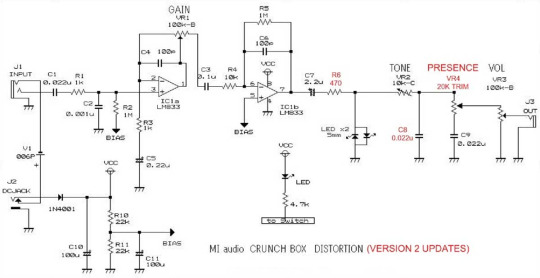
The version I put together has four knobs: gain, volume, tone, and presence. I enjoy how this pedal sounds with different guitars. In the video, I play a 2011 Gibson MM Explorer.
youtube
Suppose you want to add Marshall-style voicing to your rig and get some bright British crunch. In that case, you should consider purchasing or building one of the pedals based on the Marshall Guv`nor circuit.
0 notes
Text
fender really just does not do a whole lot for jaguar players like you want a jaguar??? well here's like 2 options with original specs buddy. and it only comes in like black or sunburst
not directly my problem cause my pick is usually jazzmasters (I have one) but my girlfriend wants a jaguar, and it's even harder to like find one that matches preferences than with jazzmasters
like you want original specs (original single coils, original tremolo, original or mustang bridge, original electronic layout and switches, and rosewood fretboard) + an interesting color that isn't just black or sunburst??? noo way. nuh-uh.
your options will be either out of production and kinda rare or absurdly expensive american made guitars
and also when you do find a model that has all that and comes in interesting colors (like a squier vintage modified or maybe fender 60s lacquer if you can find one) the preferred colors will still usually be impossible to find, like the vintage modified model had a candy apple red variant which looks great but I have never seen one for sale
0 notes
Text
The Five Most Iconic Fender Guitars

Fender guitars have long been revered as icons in the world of electric guitars. Since its founding in 1946, the Fender Musical Instruments Corporation has continuously pushed the boundaries of guitar design and craftsmanship, creating instruments that have left an indelible mark on popular music.
STRATOCASTER: THE ICONIC STANDARD
One of the most iconic Fender guitars is the Stratocaster. Introduced in 1954, it quickly gained popularity among musicians for its sleek design and versatile sound. The Stratocaster’s double-cutaway body shape, comfortable contours, and a trio of single-coil pickups became defining features of the instrument. It was also notable for its tremolo system, which allowed guitarists to create subtle vibrato or dramatic dive bombs.
TELECASTER: TIMELESS SIMPLICITY
Another iconic Fender guitar is the Telecaster. First introduced in 1950, it was originally called the Broadcaster and later renamed the Telecaster. The Telecaster was the first mass-produced solid-body electric guitar and featured a simple yet elegant design. Its single-cutaway body shape, bolt-on neck, and two single-coil pickups made it a versatile instrument for a range of styles, including country, blues, and rock.
PRECISION BASS: THE FOUNDATION OF THE RHYTHM SECTION
Fender also revolutionized the world of bass guitar with the introduction of the Precision Bass in 1951. The Precision Bass, or “P-Bass,” was the first electric bass guitar that could be played upright or horizontally. Its solid-body design and split-coil pickup allowed bassists to play with greater volume and sustain than ever before. The Precision Bass became an essential part of the rhythm section in many genres, from rock to jazz to funk.
JAZZMASTER: FOR THE INDIE ROCKERS
In 1958, Fender introduced the Jazzmaster, which was designed specifically for jazz musicians. However, it quickly gained popularity among experimental and alternative rock guitarists in the 1980s and beyond, with groups like Nirvana and Dinosaur Jr ripping awesome solos and finding dissonant, experimental approaches to guitar playing. The Jazzmaster featured a unique offset body shape, a floating tremolo system, and two single-coil pickups with a warmer, more mellow sound than the Stratocaster or Telecaster.
MUSTANG: THE SHORT-SCALE STALWART
The Mustang was introduced in 1964 as a student model guitar but quickly gained popularity among professional musicians for its unique sound and playability. The Mustang featured a shorter scale length than other Fender guitars, making it easier to play and ideal for guitarists with smaller hands. Its distinctive design included two single-coil pickups and a unique switching system that allowed for a variety of tonal options. The Mustang, along with all of these other iconic guitars, are, of course, still available in music shops like cranesmusic.com.
An Awesome Legacy
Fender guitars have had an awesome impact on the world of music and continue to inspire musicians of all genres. From the timeless simplicity of the Telecaster to the experimental sound of the Jazzmaster, Fender has created a range of instruments that have become iconic symbols of rock, blues, country, and beyond. The Stratocaster, Telecaster, Precision Bass, Jazzmaster, and Mustang are just a few examples of the enduring legacy of Fender guitars, and their influence will be felt for generations to come.
https://techchuck.com/2023/05/19/the-five-most-iconic-fender-guitars/
0 notes
Text
Ty segall band tabs

#TY SEGALL BAND TABS SERIAL#
#TY SEGALL BAND TABS FULL#
I’ve played a lot of Quad Reverbs and the silverface Fenders are all over the place. What amps did you use on the record? Segall: My main squeeze is a ’72 Fender Quad Reverb. My main guitar now is a Les Paul with P-90s. I actually don’t have that guitar anymore. Instead of the original P-90 pickups, it had Seymour Duncan Antiquities in it. Emmett Kelly: The guitar I played on the record was a modified ’59 Les Paul Special. There’s no whammy bar or anything on the Les Paul, so I’ve had to step up my actual playing instead of relying on sound effects. Have you found that your style has changed at all since you got the Les Paul? Segall: With the Mustang, I was super-reliant on the tremolo bridge. It’s like a grown-up’s version of an electric guitar.įor his new album, Segall enlisted the skills of veteran indie-rock producer Steve Albini, who got beefy guitar tones and kept the tracking lean. The sustain is insane compared to the Mustang. The Mustang-it’s bright and twangy, whereas the Les Paul is full-bodied, resonant. What’s it like going from the Mustang to the Les Paul in terms of sounds? Segall: It’s like a similar thing with how it feels. It feels like a toy compared to the Les Paul. I wouldn’t say I’m technical or anything, so it’s funny, now going back to the Mustang-realizing it’s a three-quarter scale. I don’t know much about guitars really, and I’m not like a studied guitar player. Before that, I played a Mustang kind of exclusively. It’s totally beat to shit, but I love that thing.
#TY SEGALL BAND TABS SERIAL#
I play a ’69 Les Paul, but I got it looked at, and supposedly it’s a late ’50s one that just has a ’60s serial number. I chatted to Segall and Kelly about the period-correct gear they used in creating those sounds, how Albini captured them perfectly in the studio, and how their home state of California plays into all of this. Joined by guitarist Emmett Kelly, multi-instrumentalist Mikal Cronin, drummer Charles Moothart, and keyboardist Ben Boye, Segall continues to explore pre-1980s sounds on the recording while stretching out with extended jamming and clearly relishing the energy of leading a live band.
#TY SEGALL BAND TABS FULL#
Segall recorded with a full band for the first time on his latest album, which is also called Ty Segall. “I’ve played with people where you’re both racing each other to the finish line or some shit like that, and that’s totally wack.” -Ty Segall He approaches the guitar in an appropriately non-schooled way, getting maximum mileage from a select palette of harmonic and melodic sources, all with great frenzy and groove. Since releasing his self-titled debut in 2008, Segall has played most of the instruments on his albums. But over the past decade, working solo and with various bands in the Bay Area and Los Angeles, he’s already created an impressive body of work that neatly synthesizes the sounds of his wide-ranging 1960s and ’70s influences: surf and garage rock, and early metal, among others. Segall, a native of Laguna Beach, California, isn’t yet 30. Segall’s label, Drag City, posted a video of the act (the YouTube search term is “A Flush Down the Tylet”) to its website without any explanation, but this weirdness was hardly surprising coming from a musician known to perform onstage in an elaborate satanic baby costume. Albini pushed the porcelain bowl, emblazoned with Segall’s name, off a loading dock, causing it to shatter into many pieces, and Segall finished off the job with an axe. Last November, singer-songwriter and guitarist Ty Segall smashed a toilet with the help of the legendary producer and engineer Steve Albini.

0 notes
Photo

A few days ago we had a little discussion about the differences between a #DuoSonic and a #Mustang, so here is a direct comparison between my 1965 Duo-Sonic II and my 1969 #CompetitionRed Mustang. As you can see, other than cosmetic differences such as the colour/finish (the earlier #guitar will be finished in #nitrocellulose and the later one in #poly) and #pickguard, they are almost identical. Except for one thing: the Duo-Sonic II is a #hardtail, and the Mustang has a #tremolo/#vibrato. #fenderguitars #vintageguitars #vintagefender #fendermustang #fenderduosonic #fenderoffset #offsetguitars #studentguitars #guitarcollection #guitarphotography
#fenderoffset#studentguitars#offsetguitars#competitionred#fenderduosonic#guitarcollection#vintageguitars#poly#guitarphotography#guitar#tremolo#fenderguitars#mustang#vintagefender#hardtail#fendermustang#duosonic#pickguard#vibrato#nitrocellulose
16 notes
·
View notes
Text
This was my very 1st, "Real" Guitar.
I purchased it at the Ramstein US Air Force Base, in Germany in 1976.
I was a 16 Year Old "Air Force Brat", at the time, and my father was an Air Force Master Sargeant, stationed at the nearby "Zweibrucken Air Force Base".
I worked all that summer in a Youth Program called "Summer Hire", just to make $$, to buy a Guitar, and I "Ended Up" with exactly $200.
The "Lowest Priced" guitar they had at the "Ramstein BX", was THIS Lone Mustang, and they had it listed at $225. It had been "Used" for "Demonstrating" Amps, and it had some rather noticable scratches in the pickguard & body, plus the strings needed replacing too, so I tried to "Haggle", and they agreed to "Knock Off" $25.
CHA CHENG! :)
I really didn't "Care" about originality, so over the years I have made modifications to the Guitar to improve "Sound, Performance & in MY opinion, the "Looks".
The 1st "Mod" was removing the UGLY "Olympic White" finish, and since I was a HUGE "Rory Gallagher" fan, I went with something that "He" had "Going On" with his Stratocaster, NO PAINT! I did, however, put some "Danish Oil" on it, for "Protection", and "Cosmetics".
The "Next" change, was replacing the PickUps with some used Dimarzio SDS-1 PickUps, "This" occured in 1980, so the pickUps were 78-80 models, the shop that sold them to me had "No History" on them, but at $30 for the pair of them, I had no reason to complain.
Then I replaced the Scratched White Pick Guard with a "Customized" one with the "American Flag", to "Thumb My Nose" at Def Leppard, and "Other" British Rock Guitarists who were putting the "Union Jack" all over "Their" gear.
Then I replaced the "Original" Tone and Volume knobs with "Fender Amp" knobs, because I think the "Original" Mustang knobs look ugly.
I "Defeated" the Tremolo by Threading Nuts onto the Two Tremolo Shafts on the "Inside" of the bridge, which very effectively converted the Guitar into a "Hard Tail".
The "Final" Mod was replacing the rather "Loose & Sloppy" tuners, with Wilkinson "E-Z-LOK", 1:19 Ratio Tuners, which was a VAST improvement with "Tuning & Intonation".
So how does the Mustang Play & Sound?
I never really, cared for the "Original" tone, it was too "Thin Sharp & Nasally", but when I replaced the pickUps, this guitar ROARED to life. At 9.36K ohm, the Dimarzio "SDS-1's" are in "Mild" PAF territory, "Output" wise, and have a tone that kind of reminds me of the Gibson P-90 "Soap Bar" PickUps.
With the "Out Of Phase" switching capability [ which is "Standard Eguipment" on the Mustang ], coupled with the awesome tone of the Dimarzio "SDS-1's", I can get anything from "Hot Rodded Telecaster" through "Stratocaster" sounds, to even "Phater" almost "Humbucker" tones just "Teasing" into Les Paul territory.
Versatility, would be the "Buzz Word" here.
I had the Neck Re-planed, Re-fretted, and the Action and Intonation adjusted in 1986, and since "Then" this guitar plays VERY VERY "Easy"!









1 note
·
View note
Text
Last week's top 20 videos (2020, week 34)
Top 20 videos last week (August 16-22)
The Story of the Morning Glory (by JHS Pedals)
WILL IT CHUG? - AmpTweaker Tight Metal (by Ola Englund)
I REALLY Enjoyed This Pedal | Crazy Tube Circuits | Space Charged V2 (by Rabea Massaad)
WHAT'S THE HYPE?? EarthQuaker Devices Plumes! (by fluff191)
Ratin Pedals Blue Angel review (by BjornRiis)
Richie Kotzen Chats about his RK5 v2 Signature Fly Rig (by Tech 21)
TLC Compressor Tech Demo (by Aguilar Amplification)
What is a Boutique Pedal Anyway? 10 Builders Weigh In (by reverbmarket)
Strymon El Capistan (by Mike Hermans)
1964 Fender Mustang + Strymon El Capistan = EPIC JAM! (by Chords Of Orion)
Fender MTG Tube Tremolo: Fender KNOWS Trem! (by Livingroom Demos)
Boss Tera Echo TE-2 (by Shnobel Tone)
Test efektového procesoru Trace Elliot Transit A (by JamStageCz)
Danelectro: ROEBUCK? (by Burgerman666)
Danelectro Spring King: A Great Analog Synth Reverb (by Sweetwater Sound)
1972 MAESTRO PS-1B PHASER DEMO. (by RACKDOCTOR)
AC noises RESPIRA & AMA + SOMA Laboratory Lyra-8 (by AC Noises)
But it's not red! JHS Crimson Review (by EytschPi42)
Line 6 POD GO, HX Stomp & Helix Mojave Coyote Preset demo (by Glenn DeLaune)
Strymon - Volante (Magnetic Echo Machine) - Demo (by Ryan Lutton)
Overviews of the previous weeks: http://www.effectsdatabase.com/video/weekly
from Effects Database https://bit.ly/3gCRWkd
2 notes
·
View notes
Text
The best Guitars ever
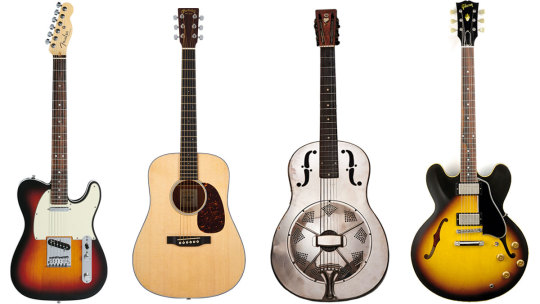
Fender’s newest Strats and Teles may not be as exciting or revolutionary as Chevy’s new Corvette (which has been around about the same amount of time), but I’m still incredibly impressed how Fender manages to provide a fresh spin on those electric guitars every few years or so. And they manage to do this without sacrificing the essence of those models too, so they appeal to modern players and vintage purists alike.
The new American Performer series is a great example of how they approach this, providing performance upgrades that expand the tonal versatility of classic models like the Strat, Tele, Jazzmaster and Mustang, while keeping original features that got it right from the beginning.
The American Performer line is true to its name. The guitars are made at Fender’s Corona, California, factory and are designed with the needs of gigging guitarists in mind, from playability and versatility to cooler-than-usual styling.
Even better for working musicians in today’s challenging industry conditions, the models are all impressively competitively priced, even though they offer a multitude of custom upgrades that most competitors would sell for a pretty penny extra.
Features
Selections for the Stratocaster HSS consist of 3-Color Sunburst, Aubergine (both with rosewood fingerboards), Black and Satin Surf Green (both with maple fingerboards), while the Telecaster comes in Honey Burst, Satin Sonic Blue (both with rosewood fingerboards), Vintage White and the incredibly cool shiny copper Penny (both with maple fingerboards).
The real beauty of these instruments lies deeper than their striking looks. Both feature newly designed Yosemite single-coil pickups that blend Alnico 2, 4 or 5 magnets in various installation positions, which are shellac-dipped (as is the case with many '60s Fender pickups) for open-sounding tone, and wound to provide optimum tone for their respective positions.
The Stratocaster HSS has a Double Tap humbucking pickup at the bridge with a coil-splitting function that is engaged via the lower tone knob’s push/pull pot. Both models are equipped with a Greasebucket tone circuit that maintains gain and clarity when you back down the Tele’s master tone or the Strat HSS’s bridge tone controls.
Playability and performance upgrades to both models include 22 jumbo frets installed on the necks, which have a 'Modern C'-shaped profile, 9.5-inch radius and satin finish. New ClassicGear tuners provide an ultra-accurate 18:1 ratio and super-smooth feel.
Today's best Fender American Performer deals
Purists and perfections will particularly appreciate the elements Fender didn’t change. The American Performer Telecaster has a vintage-style 'ashtray' bridge with three brass barrel saddles, which Tele enthusiasts insist is essential for definitive Tele tone.
The American Performer Stratocaster HSS has a six-saddle vintage-style synchronized tremolo bridge, and the late-'60s/'70s-style oversized headstock is a welcome detail for discriminating tone connoisseurs - just ask Jimi, Ritchie or Yngwie. Both models feature alder bodies as well.
Performance
The tones are ballsy and full-bodied, hitting the amp’s front-end with Manny Pacquiao punch and singing with Freddie Mercury sweetness. The coolest aspect about the Strat HSS’s pickups is that the output is perfectly balanced between the humbucker’s dual-and split-coil settings as well between the full humbucker and middle/neck pickups.
While the jumbo frets certainly measure meatier than typical medium-jumbo frets, they don’t feel overly big under the fingertips, providing satisfying fast and smooth action and maintaining body and sustain when pushing bent notes to the limit. The 'Modern C' neck profile is slim but feels substantial and solid in the player’s hands. These are some of the most comfortable stock Strat and Tele necks I’ve ever played.
The overall construction quality is immaculate and flawless. The necks fit super-snug into the body pockets, every screw is perfectly installed and the overall attention to detail is shockingly good for guitars in this price range - and beyond! Whether you’re looking for a first Strat or Tele or considering an upgrade, the American Performer series models are very worthy contenders.
· New Yosemite single-coil pickups are individually voiced to each model and installation position.
· The Greasebucket tone system maintains clarity and consistent gain no matter where the tone knobs are positioned.
· The Stratocaster HSS has a DoubleTap humbucking pickup at the bridge with a coil-split function accessible via the lower push/pull tone knob.
· The Telecaster has a vintage-style 'ashtray' bridge with three brass barrel saddles that deliver classic Tele twang.
THE BOTTOM LINE: Fender’s American Performer solidbody guitars offer gigging guitarists incredible value for a US-built instrument with upgraded features and classic essentials that discriminating players demand.
1 note
·
View note
Text
i wonder if it would be worth it to fill in the bridge cavity of my strat and replace it with a mustang tremolo
#textpost#you know how really good craftsmen can make things unrecognizable from how they started? i want my strat to end up like that#the next major upgrade is a wider neck#the tremolo replacement is just because the arm gets in the way when i palm mute the high strings#the electronics need some cleaning up too so they stop shorting out all the time
1 note
·
View note
Video
instagram
This is the intro to a song I've played on here before, but I keep trying new sounds. I'm planning the next batch of songs, so I'm seeing which ones work best together. Just trying out a faster chorus here, maybe as a second part for the second verse. I thought it sounded pretty cool. . . This is my Fender Vintera Mustang, tuned to E standard, going through the Fender Deluxe Reverb Tremolo channel, volume at 3. Drum machine is a Boss Dr. Rhythm DR-660 at 120 BPM through an Acoustic 320 and a 4-10 cab . . Signal Chain: Boss TU-3 Chromatic Tuner, Morley Volume Pedal, MXR Micro Amp, Fender The Bends Compressor, Fender Bubbler Chorus, Fender Mirror Image Delay, Fender Marine Layer Reverb. . . 🎶🎵🤘 . #fender #mustang #fenderdeluxereverb #guitarist #bassist #musician #originalmusic #metal #rock #heavyrock #heavymetal #gothic #doom #popmetal #sludge #prog #shoegaze #blackgaze #blackmetal #ambient #nevertooold #cruellogic #cruellogicband @ehx @jimdunlopusa @tcelectronic @bossfx_us @fender (at Ocean County, New Jersey) https://www.instagram.com/p/B-k3KEknEy5/?igshid=8logzq9yn36q
#fender#mustang#fenderdeluxereverb#guitarist#bassist#musician#originalmusic#metal#rock#heavyrock#heavymetal#gothic#doom#popmetal#sludge#prog#shoegaze#blackgaze#blackmetal#ambient#nevertooold#cruellogic#cruellogicband
1 note
·
View note
Text
News e... ampli?
Eccoci qui, blog non seguito da nessuno... non scrivo da un bel po’!
Certo, il tempo “scarseggia” e pensieri ce ne sono.. ma alla Musica non si rinuncia!
Ci eravamo lasciati con l’indecisione riguardo pedalanza varia.. Alla Helix Floor ho affiancato un DigiTech JamMan Solo XT (perché aveva la schedina SD, sempre in dubbio se cambiarlo e riprendere il buon vecchio Boss RC-3, più che altro per le drum loop), ho mantenuto il fantastico FreqOut e ho messo come pedale espressione un EHX Expression Pedal (che uso con la Helix per comandare il Whammy). La pedaliera è la PedalBay 80 della Palmer.. bella con la sua custodia e non mi spacco la schiena (la Helix ha simulazioni bellissime di pedalini che uso alle prove mentre in concerto, beh, i 4 canali del Powerball II mi piacciono troppo). L’ampli è quello che cercavo, coi suoni che cercavo e col cambio valvole è incredibile.. la pedaliera.. beh, ero restio a vendere 21 pedalini (20, uno l’ho tenuto) ma.. anche lei è una bella bomba, con un bel displaye e una macchina davvero professionale. Sono molto felice di essere riuscito a prenderla (col tanto dei pedalini l’ho presa nuova).
Eccovi le foto dell’Engl e della PedalBoard:
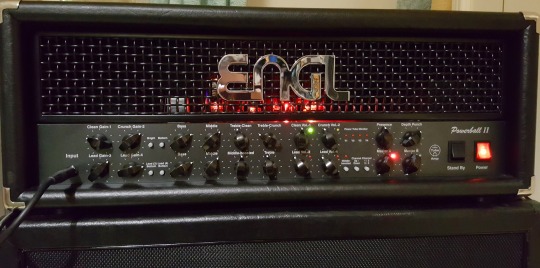
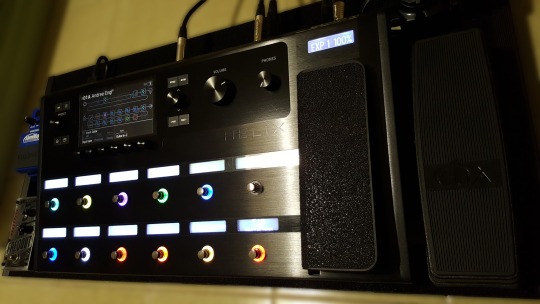
Sul versante chitarre invece ho preso la “seconda” di Snow (l’ho chiamata Storm). Una Ibanez RG Premium red desert, si, il colore ha stupito anche me. Completa di tutti gli accessori e borsa strabella monta un Seymour Duncan Jazz Neck, un Seymour Duncan Quarter Pound (venduto per mettere un SSL-1) e un Seymour Duncan JB al ponte. Spettacolare nel suono e nel feeling, e anche esteticamente!

Altra chitarra che ho preso è una Telecaster, giusto per curiosità, a cui ho cambiato immediatamente il battipenna mettendone uno nero preso da Amazon.. quello bianco non mi piaceva. Bello il feeling e davvero interessante il suono single coil, ovviamente questa “resta in casa” insieme alle altre che uso sporadicamente per via di un approccio meno versatile rispetto alla Prestige e alla Premium ma.. ha il suo bel fascino e il suo fantastico suono.

Ultima cosa: attaccare la Helix è facilissimo: metti i cavi, attacchi la ciabatta che alimenta anche i due DigiTech et voilà, fatto. Solo che ogni singola volta far scaldare l’Engl per suonare (oltre l’ingombro) è una cosa fastidiosa. Se ho voglia di suonare/studiare quando ho tempo libero dover lasciare tutto in giro o attaccare tutto è un po’ problematico. Avevo un Fender Mustang GT 40, ottimo, bellissimo, con display etc. Ma rievoca brutti ricordi, l’ho venduto. Quindi ero indeciso tra 3 amplificatori modeling per fare un “plug&play” a casa o in trasferta, non per concerto. La scelta è andata a uno di questi 3.
Line 6 Spider V 60
Ottimo su tutta la linea, ha lucine e display e possibilità di avere una pedalboard da attaccarci. Pro: ha un sacco di suoni ed è qualitativamente ottimo (ha anche looper e drum machine), sarebbe la pace dei sensi. Contro: forse ho troppo digitale, mi manca l’analogico.. anche perché uso gli effetti della Helix. E’ una cosa di testa. La versione MKII è introvabile usata, ma quello conta meno, dato che aggiornando il firmware dell’MKI rende tutto uguale alla nuova versione.
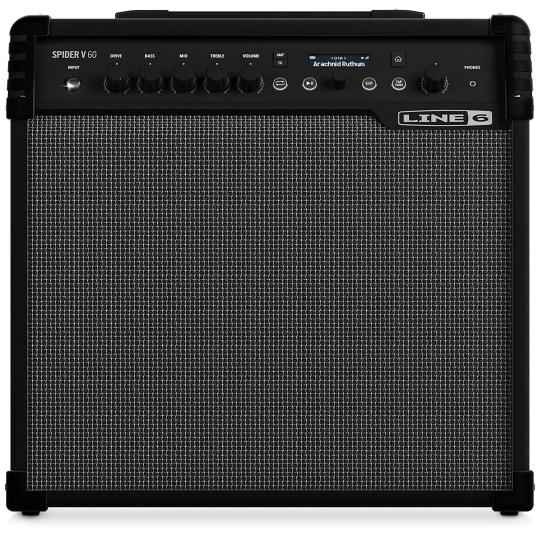
Marshall Code 50
Criticato e amato, ha tante simulazioni di ampli e fino a 5 effetti in contemporanea, con la possibilità di utilizzare l’app via bluetooth. Pro: bel display, simulazioni davvero credibili stando ai video online. Contro: Marshall.. solo quei suoni? Non sono mai stato troppo amante del suono british e Marshall ma, si sa, si cambia... poi le opinioni online lasciano il tempo che trovano.

VOX VT40X
Semivalvolare, dall’ottimo suono, tante variabili, controllabile via app del telefono. Pro: la valvola e la versatilità, ha dei suoni davvero convincenti e molto valvolari. Contro: solo 3 effetti alla volta e niente display, ma ha la valvola...

Alla fine si è aggiunto anche un altra incognita: io voglio passare un po’ di tempo tornando all’analogico, avendo la Helix mi manca il “vintage” e ho pensato ad un Marshall MG30FX Gold (possibilmente la versione del 2018). Con 4 canali, chorus/phaser/flanger/delay e reverb (manca il tremolo!) a detta di molti con un suono dalla timbrica Marshall.. per studio/trasferta andrebbe benissimo.. inoltre sarebbe un ritorno al vintage e un approdo ad una marcha che ho sempre poco tenuto in considerazione.. ma si cambia nella vita, si sperimentano suoni diversi.. o no?

Se solo trovassi la maniera di provarli.. alla fine tornerei sempre sul full digitale come lo Spider V... tanto lo so! Solo il tempo potrà dircelo. Servirebbe un ampli con looper e drum machine anche perché, in un futuro lontano, vorrei liberarmi della Zoom G5 per prendere il Pod Go.. ma la Zoom la uso come “pedali singoli” e il Pod Go (seppur qualitativamente come la Helix) non mi dà quei 6 switch per fingere, ancora una volta, di avere dei pedalini singoli sotto i piedi (come faccio pure con la Helix).

Grazie di tutto e a tutti!
Keep rockin’
Andree
0 notes
Video
undefined
tumblr
65’ Fender Mustang 🎸with Tremolo Arm 💪🏻 @yoshiaki_imahori . . . #sgstrings #fender #65fendermustang #mustang #silentbay #オリジナル曲 #マスタング #ムスタング #vintageguitar #vintageguitars #marshall #marshallamps #yoshiakiimahori #pickupjazz #guitarstagram #arming #tremoloarm #tremolo #whammybar #whammy https://instagr.am/p/CJGsO47g8hj/
0 notes
Text
Everything You Should Know About Whammy Bars
It’s tough to enjoy all types of guitar music without the thrill of the whammy bar.
Some understandably despise the whammy, while others only jam with one.
Either way, you should acquaint yourself with the knowledge of what makes these guitar additions so unique.
Not every guitar has one of these magical little apparatuses but, among those that do there is a wide variety and diverse setups that each require a different format.
You can utilize a whammy bar for a vast variety of playing styles and types of music from the subtle cat purr to heavy metal dive bombs and the awesome textural variety of bands.
A large portion of playing guitar is sense of feel and it’s amazing what this little lever can do to enhance that sense.
The reality is, many guitarists don’t appreciate what makes one whammy bar different from the next.
Fortunately, we’ve created this article to enlighten you with all the whammy bar information you’ll ever need.
What do whammy bars do?

A Whammy bar, or as it sometimes known, a tremolo bar simply alters the tension on the strings all at once.
Some guitars with whammy bars have what is called a floating tremolo, which means the strings can be loosened, lowering the pitch, by pushing the bar towards the guitar body, or the strings can be tightened, therefore raising the pitch by pulling the bar away from the body of the guitar.
Because the tension of each string is different, and the effect of the changing tension differs, depending on the frequency of the note, the variation in the pitches of each string is dramatically different, so the guitar does not stay in tune as the bar is moved.
The drawback of a whammy bar installed on your guitar is that when you break a string, the entire guitar goes out of tune because the tuning is a balance between the string tension and the whammy bar springs on the underside of the guitar.
When one string breaks, the spring tension pulls harder on the remaining strings sending them out of tune as well.
What’s the difference between a whammy bar and a tremolo bar?

Let’s start by getting the terminology straight: tremolo/vibrato/whammy bar/arm, and tremolo/vibrato system/tremolo bridge all refer to pretty much the same things.
Technically, the effect is a change in vibrato, because manipulating the bar changes pitch. Tremolo, on the other hand, refers to a change in volume.
But the two terms have come to be used almost interchangeably. Whammy is just the nickname for the locked tremolos.
Usually people use the term Whammy when it’s a “tremolo” that can be dive-bombed, abused, frilled, etc.
The proper term for the “whammy bar” is “vibrato arm“. A “tremolo system” refers to all components of the tremolo unit, which can include the tailpiece, the bridge, the nut and the tremolo bar.
And it helps to know that the terms “tremolo bar”, “vibrato bar” and “whammy bar” are all used interchangeably—as are the terms “bar” and “arm”.
Why is it called a whammy bar?
The term “whammy” is an onomatopoeic slang term that has come into use since the 1950s. It is most often associated with bridges that can perform extreme pitch bends.
The first whammy bar came from the Fender Stratocaster design, and were followed later by the Floyd Rose and Kahler designs.
There are two main types of whammy bars, the detachable ones (Floyd Rose and Fender style) and whammy bars that require a tailpiece (Bigsby).
A Whammy bar is a lever attached to the bridge or tailpiece of an electric guitar that can be depressed to increase the tension of the strings and produce such effects as vibrato, portamento, and dive bomb.
Who invented the whammy bar?

Whammy bars, are often referred to as tremolo or vibrato bridges.
If we’re getting down to details, are pretty commonly found on popular electric guitars throughout the world.
They go back to the 1930s when Doc Kauffman created and patented the very first mechanical vibrato unit.
After building this device, originally known as the “Vibrola,” on a few Epiphone Archtop guitars during the late ‘30s, the design took off. Every guitar company wanted in on the action.
Merle Travis, a favorite country guitarist of the time, was sick of his guitar going out of tune thanks to his unreliable, spring-loaded Vibrola.
He commissioned his friend, Paul Bigsby, to fix it. Paul ended up going overboard with his “fix” and ended up creating the first true vibrato system, the Bigsby.
The Bigsby Vibrato has a rocker bridge as the main component. Instead of the strings going through holes, they wrap around a metal bar that is attached to the tremolo arm.
A guitarist can push the arm down and loosen the strings to get the drop in pitch.
Before the Bigsby vibrato/tremolo bridge came out, the idea of the whammy bar hadn’t quite reached the general public.
Today, the Bigsby is probably one of the most unique whammy bars around. It has a smooth, easy-to-use feel, and is often seen on vintage, archtop guitars.
In terms of staying in tune, it’s not the best, and its pitch bend is not as dramatic as others. Basically, if you’re looking for a smoother, more subtle whammy bar, the Bigsby is one of the best.
The next advancement in the world of tremolos came from Leo Fender, the head designer, and inventor of Fender guitars. The Fender synch tremolo first appeared on the Fender Stratocaster, released in 1954.
The idea was to create a tremolo with a greater pitch range, as well as a tremolo that was capable of bending up.
When Leo Fender came up with his tremolo design, he decided to make the first ones with floating bridges before sticking with the more stable synchronized tremolo.
The reason it was named the synch or “synchronized” tremolo was because the saddle and strings were meant to move in unison like one significant movement.
This helped to eliminate string friction with the saddle, and in turn, helped the strings to move back to their original tuning and tension when the bar was laid to rest.
In terms of design, the tailpiece is made out of a singular piece of metal that sits flush in the body of the guitar, with holes in the top to allow the strings to go through.
The actual arm moves through the bridge and into the tailpiece, making it far more stable than the Bigsby.
Most modern tremolos used this design as inspiration to innovate with. It is easily one of the most influential whammy bars in history.
In 1979, Floyd D. Rose developed the very first locking tremolo, known today as the Floyd Rose Tremolo.

Many people believe that Eddie Van Halen was the man who pushed the Floyd Rose Tremolo to stardom, as he was one of the most prominent Shredder-style guitarists of the time.
Still to this day, if you are a rock or metal guitarists, a locking tremolo is a must.
The actual design of the locking tremolo shows a ton of influence from the Fender Synch tremolo, though the big difference is that the strings are locked in place for stability in tuning and intonation.
The way it works is you tune your guitar as desired, and then lock the nut and bridge with the included Allen key.
This meant that you could tune down to a drop D or C and still remain in tune while dive-bombing those low notes.
Because the Floyd Rose locking tremolo is a floating system, the pitch can be raised or lowered without much work.
This is because there is an open space behind the tremolo where the springs “float” between the tremolo and body.
If you’re looking to get those Eddie Halen-style dives and bends, look no further than a locking tremolo.
You’ve most likely seen these types of bridges before, as they raise up off the body of the guitar.
The reason so many people love this style of bridge/whammy bar is that you can manipulate the pitch up or down much easier.
The action sits much lower as well, meaning you can use it to give life to those long chord strums.
The main issue with floating bridges is that they go out of tune very easily if one string bends or breaks. This is because the strings on a floating bridge are balanced together.
However, if you’re looking for something that is a bit more natural sounding to help sweeten up your playing a bit like Stevie Ray Vaughan, a Fender Floating Bridge is your best bet.
These types of tremolos were found mostly on old Jazzmasters, as well as Jaguars, Mustangs, and a few vintage Fender Bass VI guitars as well.
Can any guitar have a whammy bar?
Technically, yes.
However, depending on what type of guitar you have, your tuning will be affected by heavy use of the whammy bar.
Cheaper guitars will go out of tune much faster than higher quality guitars.
The other downside of adding a whammy bar is the added abuse or tension on your strings will still cause them to stretch and weaken faster than a fixed bridge.
Additionally, the spring in the tremolo will become progressively weaker over time.
A good tremolo is designed to reduce this effect as much as possible, but it’s still a tradeoff to consider.
Fitting a new bar on the guitar can be a little tricky and we highly recommend you seek out and have this kind of work done by a professional.
I say this because you may need to cut a new hole, with some precision in your guitar, in order to make room for the mechanism.
How do you keep a whammy bar in place?

Bar falling into the body?
First of all, it’s worth noting that different models will have different springs, and some are stronger than others.
If this keeps happening to you and you’re using heavy strings, try using lighter strings.
A key issue in using the whammy bar occurs when strings become slack and therefore change position in the nut.
When the whammy bar is returned to neutral, friction at the nut can prevent the strings from returning to their original, natural state, and this can be a large cause of tuning issues.
Start by replacing the nut, or if that is not an option, attach a rubber band from the whammy bar to the bottom strap button. For a more permanent option, superglue is always a choice.
Conclusion
If you really want to learn how to use a whammy bar you should really just spend some time experimenting around with it first.
Try playing a variety of different chords and dropping the arm down to see how the sound reacts.
Dropping the bar at different rates will give you altered sounds so you will have to practice and get a good feel for what sound you are looking for.
Alternatively, you can also do the opposite and start with the bar dropped and raise it.
If you move the bar gently while you’re playing you can get the softer noises as well. It’s really all about having fun with manipulating sounds for a unique style.
Whammy bars are the highpoint of pitch-related effects in the realm of guitars.
Love them or hate them, there’s just nothing quite like using this handy tool to sweeten up your sound and add life to your guitar’s tone.
Understanding the different varieties of whammy bars can help you to know how to make your guitar function in your own way.
We hope that this article helped give you all the insight you’ll ever need on these fantastic devices.
As always, please feel free to let us know if you have questions or share your thoughts of how you use a whammy bar.
Keep rocking and jamming and whammy on!
The post Everything You Should Know About Whammy Bars appeared first on Sustain Punch.
source https://www.sustainpunch.com/whammy-bars/
0 notes
Photo

^&**^ Mint 2007 FENDER MUSTANG Electric Guitar Tremolo '65 RI Reissue Japan Hard Case https://ift.tt/2Zip09R
0 notes
Photo

Questa è la mia Jackson... col volume a forma dì teschio e la tracolla che non ha bisogno di presentazioni 😀 il suono è (ovviamente) devastante e super rock! Ho abbassato l’altezza del’humbaker al manico ed alzato l’humbuker al ponte... così quando ho un solo sposti la levetta indietro ed ho un suono più acuto e più alto di volume 😀😀 Ora monta le 0.11 perché è accordata in Re e la uso in alcuni brani (per esempio Non Resterò Sola) in cui non voglio rinunciare alle corde a vuoto anche in altre tonalità! Quando la collego al mio Fender Valvolare è da panico puro!!! ...comunque anche quando uso il Fender Mustang a transistor ha un suono interessante... molto fuzz 😀😀😀 ma sempre potente! Non ha la leva... ponte fisso... ma se appoggio il gomito destro sul corno alto, si ottiene un tremolo eccezionale 😂😂 il suo nome? Yellow, e la adoro!!! Mi è stata regalata per il mio decimo compleanno, ed ho già fatto molti live con lei e non mi ha mai deluso! Grazie Yellow ❤️❤️❤️ Maya #jacksonguitars #mayafoti #giannifoti #chitarraelettrica #fender #music #Mayaelaprofezia #cantautore #livemusic #rock #tscrecords #MayaELP #telecaster #relic #heavyrelic #prs #prsguitars #photo #fashion #talent #webtalent #follow4follow #pleasefollow #me #love #cute https://www.youtube.com/c/MayaFoti http://www.tscrecords.com/2008/12/maya-foti.html https://www.instagram.com/p/B6TbCGZor4M/?igshid=6l3a6j55l7zk
#jacksonguitars#mayafoti#giannifoti#chitarraelettrica#fender#music#mayaelaprofezia#cantautore#livemusic#rock#tscrecords#mayaelp#telecaster#relic#heavyrelic#prs#prsguitars#photo#fashion#talent#webtalent#follow4follow#pleasefollow#me#love#cute
0 notes